a whole week gone, since last I wrote a start. Not sure where.
This week a few more of our centenaries, two Wills cards (which are always lengthy to describe) and several biographies. Sounds like I thought I would have lots of time, but I did not, though as always I have done my best and that is all that one can do. And these newsletters are always but starting points, to be filled in forever whenever something new comes to light and flutters before me.
So what, you may be wondering, have I unearthed for you this weekend. Well there are two winning bowlers, a not so frequent talker, an Aboriginal Activist, a Doc who was a Dentist, a Little Lamb, and a fibre that failed. .... or was fried....

W.D. & H.O. Wills [tobacco : UK - Bristol & London] "Sports of All Nations" - Three Castles brand (1900) 8/50 - W675-070E : W62-58E : W/14
Straight along the green and into our first centenary card, which is one of the bowlers. Now I am not totally sure this card works here but I found no other. I am also stymied by the fact that a lot of modern (and some vintage) American cards think that bowling is ten pin bowling and not the genteel British game.
The centenary is of the birth of Eric Liddell, but not the athlete, the lawn, and indoor bowler, who was born today in 1924 as Eric John Liddell, in Victoria, Australia. After serving in the Second World War he seems to have become out of sorts with life in Australia and emigrated to Hong Kong, for whom he thereafter played. In fact he represented them at the 1954 British Empire Games, and in six more Commonwealth Games after that, the last being in 1978.
In 1980 he was part of the team that won the gold medal at the Outdoor Championships in Melbourne, after which he retired from bowls, and decided to go back to Australia again. He died in 1991, aged just sixty-six.
I have not been able to find him on any cards, but hopefully you know of at least one.
That meant that I had to look for cards of bowling, of which there are also few, though I did briefly flirt with the idea of the Senior Service branded "Our Countryside", issued in 1938, where card 34 shows a village bowling green at Stoke in Teignhead. There are also several cards of bowlers, but it seems odd to celebrate one man with a card of another. So, as this one will tie in with the other versions of this set, (and we have already featured "Traveller" and "Westward Ho", which is where the main entry for this set resides) it got the nod - also it is a lovely clean and dark example, because often I struggle with the light grey backs of this set.
Our brand, "Three Castles", is said to have been produced between 1920 and 1950, but that is incorrect because this card is twenty years earlier. I think the confusion may be because at the time our set was circulating the brand was only used in Australia. A bit more digging and I have found that both "Three Castles" and "Gold Flake" joined the Wills`s stable in 1878.
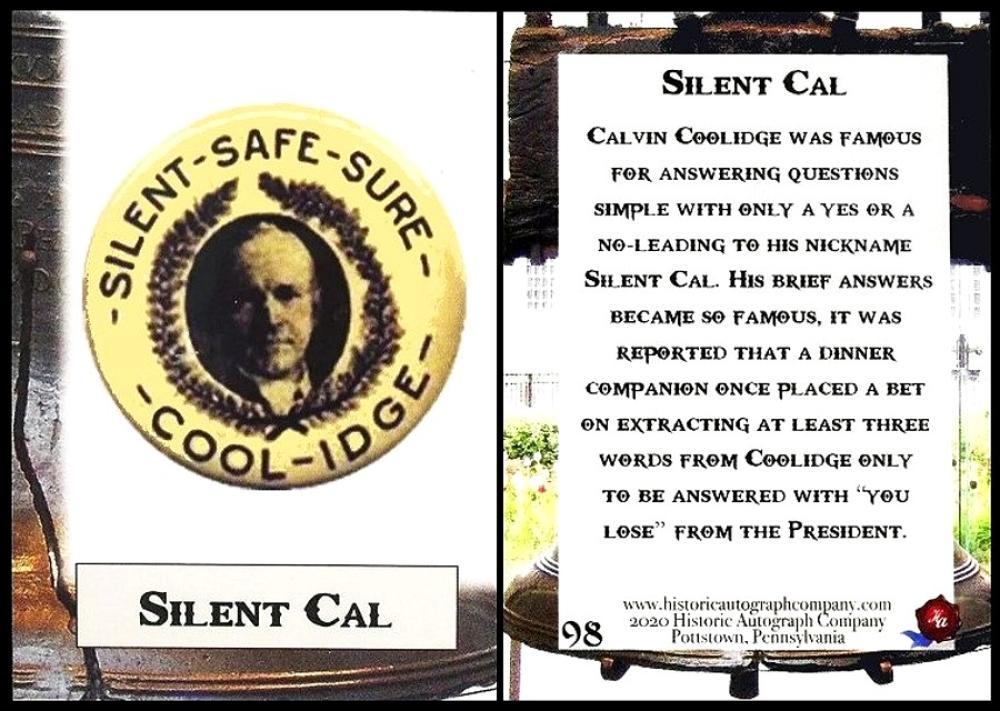
Historic Autograph Company [commercial : O/S - USA -Pennsylvania] "POTUS The First 36" (2020) 98/109
A curious centenary now, because today in 1924 saw the first sound recording ever to be made of an American President. And even stranger it was of Calvin Coolidge, who was not exactly talkative, in fact our card says it all, even just on the front, where he is called "Silent Cal".
You can actually hear the recording for yourself on YouTube/CC.
This set is called "The First 36" because it only covers the first thirty-six Presidents of the United States - and, by the way, POTUS is an acronym for that very job (President Of The United States), FLOTUS being his wife, or First Lady. However it is not only portraits of people, it also covers American events and there are some curiosities, like a card of George Washington`s teeth, which were thought to be made of wood, though they were actually ivory.
Now I did wonder if the badge featured on the front was issued by a tobacco company, because the early American ones did make badges as well. But I have not yet tracked this one down. Also I think that they were earlier and this is a 1920s one. But I would be interested to hear from you about this. It does not appear amongst the collection at the Coolidge Foundation either.
Calvin Coolidge was the thirtieth president, and he was born, rather interesting, on the fourth of July, 1872. He was a lawyer, and only became President because of the death of President Warren G. Harding, having been his Vice President. He was away on holiday at the time. Though some undoubtedly felt that he got the job by default, Coolidge was very popular, and when he was formally elected in 1924 it was to mass acclaim.He would almost certainly have also been elected for another term in 1928 but he decided not to run again, and so the Presidency went to Herbert Hoover.
According to the Trading Card Database/Calv.Coolidge our man appears on a hundred and twenty-six cards. The first of these is listed to be by the United States Caramel Company and is dated as 1932 but that cannot be correct because the bottom line says that he "died January 5, 1933, very suddenly."
There is one rather fascinating fact, on the Bowman set of "U.S. Presidents", (issued in 1952) and repeated in the Topps version twenty years later, and that is the last line, which tells us that he was "said to be the first President with Indian blood". He did write in his autobiography that this was through his father`s bloodline. And it is true that he was often photographed with Native Americans, as well as being responsible for setting up a Bureau of Indian Affairs, which was to investigate treaties and policies on their behalf.
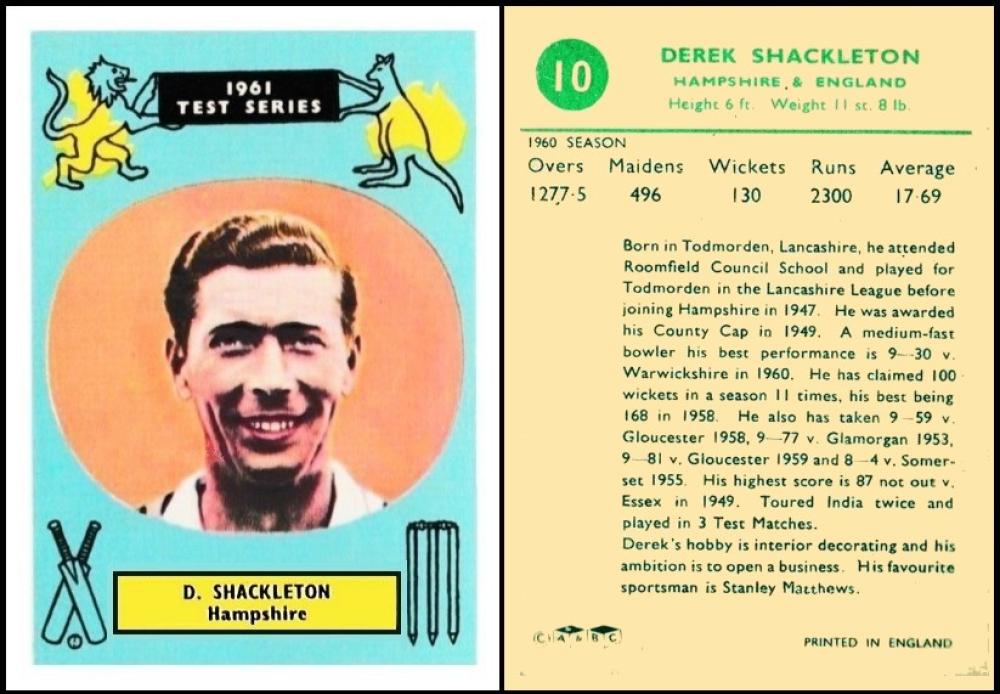
A. & B. C. Gum [trade : bubble gum : UK -] "1961 Test Series" (1961) 10/48 - AAB-200.a : ABF-5.2.A
Our third Centenary in three days brings us to this man, Derek Shackleton, who was born today in 1924. He was born in Todmorden, right on the border betwen Lancashire and Yorkshire, but he played cricket for Hampshire, as well as in seven Tests for England. After he retired from playing cricket he went on to coach, and also served as an umpire.
It could have been very different though, because he was also signed by Burnley Football Club as a goalkeeper. I cannot find out when that was, but it seems it was before he joined the Army in 1942, because during his service he was still playing both cricket and football with gusto. Then, after he left the Army, he must have been swayed by Burnley making the 1947 Cup Final, though they lost to Charlton Athletic.
However in 1948 our man was signed by Hampshire County Cricket Club, and football was a thing of the past.
Despite the year of his birth, it seems strange that he was not immortalised on a card until some while later. Our card dates from 1961, but his "rookie" card, according to the Trading Card Database/DShackleton, was not that much earlier, being the 1956 "The World`s Best Cricketers", issued with Hotspur magazine, a publication of the D.C. Thomson enterprise.
By the way, if you look at the text on this one, and are a football card collector, it may surprise you to read Stanley Matthews` name, cited as our man`s favourite sportsman. And I wonder how many Stanley Matthews collectors were aware of this card until today?
This set is trade, and it was issued with bubble gum - one packet of gum, and three cards, costing 2d. However on those packets the set is called "A & B.C. Test Cricket Series" and not "1961 Test Series" as it appears in our British Trade Index.
There are three cricket sets listed in our original British Trade Index part II, as :
CRICKETER GROUPING (A) Lg. Nd. ... ABF-5
1. Action pictures. Back with number in blue square, 96 x 67 (48)
2. Portrait in flat circle, vari-coloured surround, Titled "1961 Test Series". (48)
A. 90 x 64
B. 94 x 68
The two sizes are today known as the "large border" and the "standard border". I do not know why there were two borders, but maybe you do and can tell us.
In our updated British Trade Index the two sets above are parted as separate listings, and ours simply reads :
CRICKETERS 1961 TEST SERIES. 1961. a) 90 x 64 b) 94 x 68. Nd. (48)
Portrait in flat circle... AAB-200

W.D. & H.O. Wills [tobacco : UK - Bristol & London] "A Tour Round The World" - Vice Regal brand (1907) 8/50 - W62-243 : W/105
Returning to Centenaries now, because today in 1924 saw the birth of Mona Matilda "Monica" Clare, who was a very interesting lady indeed. And she also worked for W.D. & H.O. Wills. Hence our card.
Now we are not entirely sure that this was the right date of her birth, given the circumstances, because she was born after quite a romance sprang up between one of the daughters of the English colonists and an Aboriginal sheep shearer. Now this man was a very good sheep shearer, and travelled widely, though he must have come back around, as they say, and more than once, because in 1926 a son came along, from the same stable, as it were, and then, very sadly, his lady love died in childbirth in 1931.
I cannot find out what happened to this third child but for some reason the welfare became involved and took the two children away to a home for infants. They struck lucky and were soon fostered together to kind and gentle people; however in 1935 something happened, I am not sure what, and they were not just removed from this place, but split up and send to separate homes. She would never see her brother again.
She found herself being trained as a maidservant, and soon sent out to earn money for her training school. She managed to put up with all the deprivations, right until 1942, when she was of an age to no longer be a ward of the court, and could leave. She then rented a little flat and found employment which suited her better, and from which she was allowed to keep all her earnings. Now one of these places at which she worked was the factory of W. D. & H. O. Wills (Australia) Ltd's cigarette factory, and after work, every night, she went off and attended school so that she might know shorthand, and be able to type, and so get a better, even higher paid job.
Now whilst she was doing that she somehow met up with her former foster parents and they became firm friends. One day when visiting them, she went to a local Aboriginal community and realised that her skills could help them. She was soon studying politics and very involved with the Labour Party. She got married, too, in 1953, and had a daughter, but it is said that the marriage ties were less strong than the political ones, and the two divorced.
In 1962 she married a Building Trades Union Official, and became heavily involved in setting up committees of that Union for women workers, who were not represented. She also had a special interest in Aboriginal Laws, and frequently protested against racial discrimination, so much so that they made her Secretary of the South Coast Labor Council, and then of the entire Independent South Coast Illawarra Tribe.
Sadly not long after this she died, on July the 13th, 1973. However her legacy lives on, and will continue to do so, as long as her story can be shared.
This set is first described in our Wills reference booklet part III, as :
105. 50. A TOUR ROUND THE WORLD. Fronts lithographed in colour; backs in blue, with descriptive text. Unnumbered. 25 cards bear back advertisement for "Capstan", 25 for "Vice Regal". The subjects in this series are entirely different from both the series of the same title by Smith. Australian issues, 1907.
A. Subject titles in light blue. Two grades of board (a) thick (b) very thin card.
B. Subject titles in mauve.
I have pondered here and cannot tell whether these extremely light captions showing here are blue or mauve. I would be interested to hear which they are
There then follows a list which I will do my best to scan.
Now in part IV there is a correction to this list, it having been discovered that No.18 should read "Mount Livinia" not Mount Lavina.
In our original World Tobacco Issues Index, the pair are catalogued in section 3, "Australian Issues", and sub section 3.A "Issues 1901-17", whilst in the updated version the sections have changed, to 4 and 4.A. However the text is the same, namely :
A TOUR ROUND THE WORLD. Sm. Unnd. (50). Front with captions in (a) blue (b) mauve. Brand issue, 25 with "Capstan", 25 with "Vice Regal" backs. See W/105.
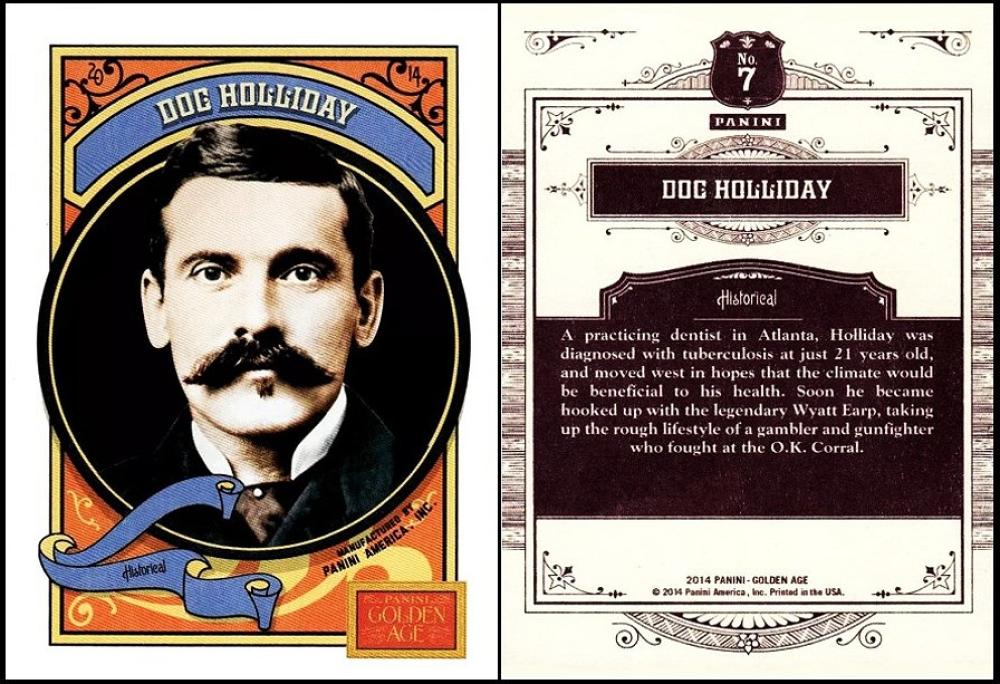
Panini [commercial : cards : USA - Texas] "Golden Age" - base set (2014) 7/150
Speaking of fighting the law, today in 1851 saw the birth of this man, who would gain his fame under a pseudonym of sorts, though it is intriguing that this was "Doc" and he was actually a dentist.
His real name was John Henry Holliday, and he was born in Georgia. Little is known of his childhood, only that his mother died, of tuberculosis, when he was just fifteen, the same disease having also killed his sister, even before he was born.
We know that when he was twenty years old he earned a degree in dentistry, and set up a practise in his home town. However, shortly after this, he was also diagnosed with tuberculosis, the doctors being of the opinion that it had been contacted whilst he was looking after his mother.
Someone told him that Georgia was not the sort of place he would recover, that he needed to move away and find a climate that suited him better. He looked at a map and settled on the South West, knowing nothing of the area. He was mildly amused to find out that it had a reputation for gambling and gunslinging, but did not think it would affect his life in any way. However one day he found himself called upon to administer medical attention to a man who had been injured in a fight in a bar room. That man was Wyatt Earp, and the surgery went well, so well that they became good friends, even both moving to the area now known as Las Vegas.
It was through Wyatt Earp that he met Mary Katherine Horony Cummings, who was three years, and many experiences, older. She was an outlaw, and gambler, and previously worked for James Earp`s wife in a "house of pleasure". As far as we know she was the only woman he ever considered as a partner, though her nickname, "Big Nose Kate", tells a story too.
We do not really know how or why the Earp brothers became such good friends with "Doc" Holliday, but they often rode together, and one day in 1879, whilst in Tombstone, where Wyatt`s brother Virgil was City Marshal, fighting broke out, at which our man was deputised in to help. This resulted in a shootout, at the O.K. Corral, at which Virgil was wounded and the other brother, Morgan, killed.
After the assailants were pursued through the country, and despatched, This did not please the local Sheriff, who issued an arrest warrant for the chasers, including "Doc" Holliday. However such was the standing of Wyatt Earp, (though some suggest that he knew incriminating evidence against the said Sheriff), that it was agreed to allow "Doc" Holliday to remain at liberty, and not be brought back to town to face trial. Then again the Sheriff may have simply agreed to this on humanitarian grounds, because our man was clearly sick, and he died, just six years later, aged just thirty-six, of tuberculosis, at a sanitorium in Colorado.
Strangely his stirring tale did not make it on to many cards at all. It seems like the first card ever to feature our man - as a "Western Badman" - was Topps` "X Ray Round Up", issued in 1949, which only has a sectional picture on the reverse and no text.
As to why he made this sudden reappearance, well in the late 1930s and early 1940s our man had been discovered by motion pictures - firstly in "Law For Tombstone (1937) where he was played by Harvey Clark. Then there was "Frontier Marshal", released in 1939, with Randolph Scott as Wyatt Earp and Cesar Romero as John "Doc" Halliday (sic). This was followed by "Tombstone : The Town Too Tough To Die", released in 1942, and starring Richard Dix as Wyatt Earp with Kent Taylor as "Doc" Holliday. Plus the John Ford directed, "My Darling Clementine", released in 1946, with Henry Fonda as Wyatt Earp and Victor Mature as Dr. John 'Doc' Holliday.
The next card of him is a bit better, and that was issued in 1966, by Leaf Gum, in the set "Good Guys and Bad Guys", which even includes his aliases, Tom McKey, and John Powers. There are a couple of inaccuracies, as it says that "John Henry Holliday was born in 1851, went to Dental College in Baltimore. After killing a man in an argument, Doc fled to Texas. Although Doc was a haggard, pock-marked man, he had a romance with "Big Nose Kate" and then joined Six Shooter Sam and other con-men working on the passengers that travelled the trains between the frontier towns. Later he joined Wyatt Earp who became his closest friend. Together they went to O.K. Corral and gunned down the Daltons, claiming they were killing outlaws. After that massacre Doc left the gang and wandered all over the West until he finally died in a Sanitarium in California at the age of 34".
I cannot trace Six Shooter Sam, nor those train robberies - however, as a prelude to the fight at the O.K. Corral, the rivals traded a lot of insults, amongst which were several references to our man taking part in such things. Also it seems unlikely that just for being part of a posse he would be wanted enough to be extradited to another state. And if we return to that first film, "Law for Tombstone", there are two strange things - firstly that the story revolves around a stagecoach line which hired an agent to stop a string of robberies - and secondly that though our man is named, there is not a mention of the Earp Brothers in the cast, Buck Jones starring as the lead, a character called Alamo Bowie.So perhaps his old crimes did catch him up and stir the pot a little?
Those two cards were the only ones to be released until the 1990s, when Victoria Gallery included him in their set of "Outlaws". Today he seems to have been re-discovered, by Topps in their various "Allen and Ginter" series, and Panini.
Our set starts as always with a base set, then there is the usual alarming assemblage of specials - you can see all of those at The Trading Card Database/GA14-Specials. The cards were sold in packets, six cards in each, and the specials were inserted randomly. In fact some people think that the base set is strictly trade, because speculators buy the packets hoping to get the valuable cards and then discard the rest, or sell them cheaply through internet auctions, so technically the base cards are like the gum of yore, the thing you pay for but get without wanting. It is an interesting theory.
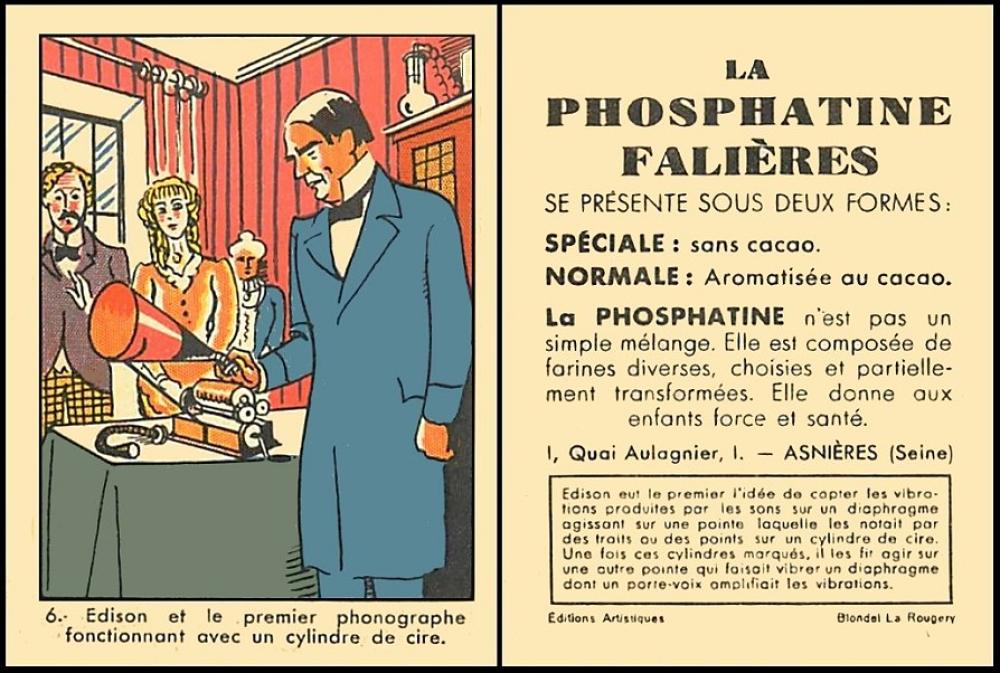
Phosphatine Falieres [trade : food : O/S - France] "Inventors"? (date?) 6/?
You may imagine that I have a thing for Thomas Alva Edison, for he seems to be such a stalwart of these newsletters. And here he is again, because today in 1877 he made the first ever voice recording, of the nursery rhyme "Mary Had A Little Lamb". Now this recording seems to have disappeared, lost in the mists of time, but in 1927 he spoke about it as part of the Golden Jubilee of the Phonograph, and also spoke the words again, and this has survived. You can also hear it at PublicDomainReview/Edison - it lasts but seventeen seconds. And I have to say I am always very impressed by being able to hear the voices of people so long gone.
The text here translates to "6. Edison and the first phonograph, which worked with a cylinder of wax". And the patent, which was issued on February 19, 1878, describes it as being a machine that a person would talk into, via the largest end of a recording horn. This horn tapered down to a machine in which was a diaphragm and a stylus, and the sound wave that this generated would make an arm move across a cylinder wrapped in tin foil, incising a groove as it went along. When it was played back the sound would appear as if by magic as the groove was retraced.
You may have noticed that I said "tin foil", and wondered where the wax on our card came from. The answer to that is that the tin foil was the first stage of development, and it was later replaced, by celluloid in the early 1910s, and then wax, and the person writing the description for this card probably only knew of the wax ones and did not research to see if there was any earlier ancestors. In fact wax remained the system of choice in dictation machines right until the late 1940s, when Dictaphone invented a method that used plastic.
Now this card was issued by "La Phosphatine Falieres" which is a kind of gruel like foodstuff for ailing and sickly children. The phosphate in the phosphatine was indeed calcium phosphate, which is still used to this day especially for sufferers of osteoporosis. Today we take it as a chewable or effervescent tablet, or as a liquid or powder added to food. However at the time this card was issued I have no idea how it was dissolved or if it even was.
All I have come across is that the Phosphatine Falieres was a kind of cross between porridge and soup, which does not sound very appetising, even though the text says it comes in two forms, "Speciale - without cocoa" and "Normale - flavoured with cocoa". Surely these are the wrong way round?
I remain certain, despite this, that many mothers and nannies were heard to mutter over the steaming bowl that things that taste bad are good for you...

Liebig [trade : meat extract : O/S - Germany] "History Of The Telegraph" (1897) Un/6 - F.0538 : S.537
Finally, and staying in an inventive mode, we have an event which happened today in 1858, the first ever transatlantic telegraph, which was sent below the waves of the Atlantic Ocean all the way from Queen Victoria to the American President James Buchanan.
The message was short, and simply congratulated the President on joining forces to build the very cable through which her words had travelled. I am not sure if it mentioned all the men of the Atlantic Telegraph Company who had constructed it or even the man in charge Cyrus West Field, or the fact that the project began four years earlier, in Ireland, with the first stretch of the cable and tube being sent into the sea. This, eventually, stretched all the way to Newfoundland.
The newspapers, despite thinking they would be outmoded by all this, applauded it wildly, for they looked on the positive side, that they could get news from all parts of the globe, and at lightning speed.
Sadly this was not to be, though, for unfortunately the cable failed in just a few weeks.At the time nobody was sure why it had failed, whether sea monsters had eaten it, or men from Mars (it is Friday, you know). Unfortunately it is now known to have been human error; or more correctly interference. The cable was good, but the message was not thought to have arrived fast enough. Enter the chief electrician, who thought he knew the solution, to ramp up the voltage. This turned out to not have the desired effect, and instead it fried the cable. It never worked again.
This set traces the story of the telegraph through its beginnings with the Romans, who used horse messengers, and hilltop beacons, then to sailors sending messages with flags, and to villagers who could somehow decipher signals by means of a contraption stuck on top of a house (no idea what is going on there really, but at such times waffling is good), via the Army who signalled with heliographs, flashing lights to other parts of their battalions, and thence to our card which shows the exterior and interior of the modern electric telegraph office, where a message is received by the staff and given to the recipient in the form of a letter.
Now this card is rather odd because the text is in German but at the bottom it says it was published in Antwerp. Or am I missing something? I also cannot find that there were any other versions. Unless you know of them, If so, do please tell.
This week's Cards of the Day...
... revolved around Polo at the Summer Olympics. Which I have found to be most interesting. Hope you have too....
The sport had its Olympic debut in 1900, in Paris, run in three heats, and there were five teams, for men only. Confusingly, four of these teams were made up of different nationalities, and even the North American team had Americans and Mexicans playing together. The fifth team was the Compeigne Polo Club and all the members were French, though one of them, Maurice Raoul-Duval also played for one of the other teams as well. The final was between Foxhunters Hurlingham, who won, which consisted of players from Great Britain and the United States, and BLO Polo Club which was made up of British, American and French players.
The next time that Polo appeared was in 1908, when the Olympics were at White City - but the Polo was played at Hurlingham. This year there were only three teams, one of which was from Hurlingham, the other two being a team from Roehampton and the Ireland National Polo Team. Hurlingham also provided the cup, but did not win, that honour went to Roehampton, and it was played in a very curious way, the two English sides going against each other, and then the winner being put up against the Irish National Team. Roehampton won both these matches, and therefore the cup, but the other teams seem not to have played each other to decide the rankings, and it was recorded as a tie for second.
Polo was not included in the 1912 Olympics, which were in Stockholm. Then the First World War came along and the Olympics did not resume until 1920, when they were in Antwerp. This time there were four teams competing in the polo, Great Britain were the returning champions, and won again; the other teams were from Belgium, who came third, Spain and the United States, who came second.
In 1924. once more in Paris, there were five teams, including the newcomers, Argentina. Great Britain were expected to win and make it a hat trick but they ended up third, beaten by the United States. And Argentina won. The other two teams were France and Spain.
There was another gap then, the sport being absent in 1928 and 1932. It resurfaced in 1936, in Berlin, and the final was held on the 7th of August, Argentina versus Great Britain, and the Argentina team won again, 15-5. That meant that Mexico got the bronze medal for third, and unplaced were Germany and Hungary.
After that polo disappeared from the Olympics, but in 1996 a little torch was shone towards it when the International Olympic Committee again agreed to recognise it as a sport. And it was shown, as a demonstration, in the Youth Olympics, in 2018, which, coincidentally, were in Argentina.
Saturday, 3rd August 2024
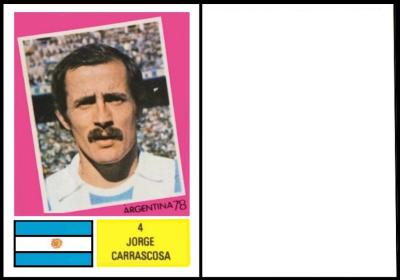
The clue here was Argentina, the current holder of the Olympic title, and possibly the first glimmer of its return to the games.
Now it may have come as a surprise to many of the spectators that Argentina were so good, but they were hotly tipped as favourites by the bookies. The reasons for this are clear, if you think of the geography, those long, flat grasslands where cattle are raised, and the horsemen who keep them in check and bring them in to face their unseemly fate. A polo pony needs to be speedy, bendy, and fast, and to be used to any kind of ground. To this day it is one of the most popular sports in that country - more than three hundred clubs, a thousand fields, and at least five thousand players. Compare this to the two hundred football clubs, seventy five stadiums, and I have no idea how many football players. Maybe you do, if so please tell us. I may have miscounted the clubs as well, but there is a list at Wikipedia/ArgentineFCs
So we started the week with this man, Jorge Carrascosa, who, quite coincidentally, was born in August (the 15th, 1948) though the truth is that I picked him for his moustache. He was born in Buenos Aires and was nicknamed El Lobo - or the wolf.
He started his footballing career in the late 1960s and made his national team debut in 1970. He was also at the 1974 World Cup in West Germany. He retired shortly after this card was issued, in 1979.
This set is sometimes just known as "Argentina 78" but its full title shows that it was issued for the World Cup. Actually some of this confusion is caused by the fact that there were two albums, one saying "Argentina World Cup 1978" and another just saying "World Cup 78". You can see those at the Football Cartophilic Info Exchange/Panini WC78
The tournament was held in Argentina, starting on June the 1st 1978, and ending on the 25th of June, with the final, which was at the Estadio Monumental, being between Argentina and the Netherlands. And Argentina won, three nil.
South American countries have a pretty good record at winning the World Cup, and also have the honour of winning the first ever one in 1930, that team being Uruguay. They also won it in 1950. Brazil was the next team to take the cup, in 1958, and they have now won it five times, the last being in 2002. The other team was ours, Argentina, who have won it twice, in 1978, and in 1986.
Sunday, 4th August 2024
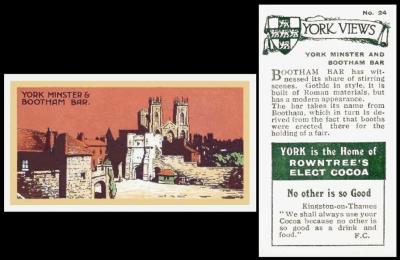
This card gave us two references to 1924, the year of the maiden Argentine victory, both in the date this set was issued and in the number of the card.
However there was also another link, which was quite fiendish, and that was the issuer, Rowntree, who first manufactured the polo sweet in 1948, starting with the original peppermint and slowly introducing a range of other fruit flavours.
What actually happened was that during the Second World War sweets were in short supply - or rather the sugar that was used to make them - and so American candies were produced under licence in British factories. Rowntree`s therefore produced Life Savers, which were hard round sweets with a hole in the middle. This licence ran out at the end of the war and so Rowntree`s decided to make their own, but of mint, to avoid any infringement of the copyright.
Now in the 1960s Rowntree`s was bought out by Nestle, and in 1994 they applied to register the polo mint as a trade mark in the new Trademarks Act. This somehow came to the attention of the current owners of Life Savers, Kraft Foods, and they objected, it seems to have gone to court as well, and it ended up with Nestle being allowed to make the mint ones as long as they added lettering on to the actual sweet so there could be no confusion. However Kraft then applied to add lettering on to their sweets as well, something to which Nestle objected, but Kraft won.
This set was picked because I thought it would be easy and the description turns out to be huge. And I am not entirely sure which of the sets this card is from. Any help gladly received - and if you have a card with a coupon details of that would also be useful, unless this has a coupon and I have not noticed....
It first appears in our original British Trade Index, which would become known as part one, and which covers issues up to 1945. In there it is listed as :
YORK VIEWS Sm. ... RPW-5
1. Front unicoloured in (a) green (b) brown (c) grey-black. Size 76 x 37 with coupon, 65 x 37 without. Numbered (24)
2. Front per Fig RPW-5, in yellow, brown and green. Subjects mostly based on those in (1) but redrawn with much detail difference.
A. Size 76 x 35 with coupon, 65 x 35 without. Back in green. Numbered (24)
B. Size about 70 x 38, inscribed at side "York is the `home` of Rowntree`s Elect Cocoa". Plain back. Without series title. Unnumbered. Probably 24 as in (A). 7 known
1. Clifford`s Tower York
2. Guildhall and Ouse Bridge from Lendal Bridge
3. The King`s Manor House, York
4. St. Mary`s Abbey, York
5. St. William`s College, York
6. Walmgate Bar, York
7. York Minster
There is additional information in part two of the original British Trade Index, which reads :
RPW-5 (YORK VIEWS)
1. Front unicoloured. Also issued as folders 84 x 38, front in green, back with 1911 calendar (six months per card). 2 known -
1. York Minster 2. The Shambles, York
2. Plain back. Add :-
8. Parliament Street on Market Day, York
9. The Multangular Tower, York
10. York Minster and Bootham Bar
You are starting to realise why this did not get finished in time, eh? In part three of the British Trade Index the plot thickens, and that entry reads :-
York Views.Two styles of picture, see Fig. RPW-5 ... RPW-5
A. Pictures in style of No.1, Fig. RPW-5. unicoloured in (a) green (b) brown (c) grey-black. 76 x 35 with coupon inscribed (1) "3d. Series" (2) "6d. series". Size 65 x 37 without coupon. Numbered set of 24, see "A" numbers. Printed back with series title. Also issued as folders, size 84 x 38, back with 1911 calendar (six months per card). Two folders known, picture in green, subjects 20 and 24 in listing.
B. Pictures redrawn in style of No.2 at Fig. RPW-5, in yellow, brown and green. Series of 24, in two printings.
(a) Printed back, with series title, 76 x 35, with coupon inscribed (1) "6d. series" (2) "1/-. series". Numbered, see "B" numbers in listing.
(b) Plain back. Illustration on left-hand side of post card, when cut off about 70 x 38. See No.2, Fig RPW-5, with inscription at side "York is the `Home` of Rowntree`s Elect Cocoa". If this inscription is cut off, cards are anonymous.
This is followed by a table which I will scan some time.
In our original British Trade Index part four, even more information appears, namely :
RPW-5.B (York Views - pictures redrawn...)
(a) printed back, with series table. Coupons are inscribed (A) "3d. Series" (B) "6d Series" (C) "1/- Series"
The description in the updated version of the British Trade Index ties all these ends together, and reads :
YORK VIEWS. All 26 subjects in these two sets listed at HR-41.. ROW-220
1. Front unicoloured in a) green b) brown c) grey-black. 76 x 37 with coupon, 65 x 37 without. Nd. (24). (Set 1 in listing at HR-41). Coupon a) 3d. series b) 6d. Series. Two also issued as folders, 84 x 38, with calendar back for 1911 (six months on each card - No.s 6 and 23)
2. Front in yellow, brown and green. Coupons found with a) 3d. series b) 6d. Series c) 1/- Series. Subjects mostly as in 1 above, but redrawn with much detail difference, found a) 76 x 35 with coupon, 65 x 35 without. Green back. Nd. (24). (Set 2 in listing at HR-41)
3. Postcard backs. Wording on left side "York is the `Home` of Rowntree`s Elect Cocoa". When cut off, size 70 x 38, anonymous. Plain back. No series title, unnumbered.
Monday, 5th August 2024
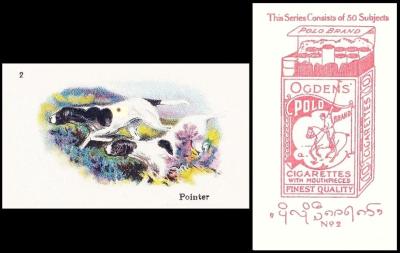
This one gave us the first picture of "Polo", but rather thrillingly, it was not revealed until the back went on at 8pm.
This card brings up an interesting point though, and that is why there was no Indian team at the Olympics, because India is considered to be the birthplace of the modern version of the game. And it spread from India, picked up by the soldiers stationed there, back to England, and thence to other areas of the globe. More about that later in the week, though we must mention that a thirteenth century Sultan of Delhi met his untimely end by being killed during a game of polo, when his horse took an unexpected fall, and he was impaled on the high front of his saddle.
This set first appears in our original Ogden`s reference book, RB.15, issued in 1949, as :
32. 50 BEST DOGS OF THEIR BREED. (adopted title). Size 63 x 35 m/m. Numbered on fronts and backs. Fronts lithographed in colour, pictures of dogs on white background. Backs with illustration of "Polo" packet, two issues.
A. Backs in red
B. Backs in blue
Issued in the East, between 1910-1915. Similar series issued by Wills.
Moving swiftly on to our original World Tobacco Issues Index, and ignoring the Wills bit just for a moment, our set is listed in Ogden`s section 5.C, which are the "Polo" brand issues. The text for this set reads :
BEST DOGS OF THEIR BREED (A). Sm. 63 x 36. Nd. (50). See RB.21/200-48.D ... O/2-205
(a) back in pinkish red
(b) back in blue
That gives us a link to an earlier volume, RB.21, which is the British American Tobacco reference book, issued in 1952, and also suggests, especially with the "D" suffix, that there were more issuers besides Wills. The full text there is :
200-48. BEST DOGS OF THEIR BREED. The small card printings of this series are recorded in W/48 and RB.15/32. There are also large size silk fronted printings, and all are summarised below :-
A. Wills` Havelock issue. Small cards.
B. Wills` Specialities issue. Small cards.
C. Anonymous issue, with letterpress on back. Small cards.
D. Ogden`s Polo issue. Small cards with backs in (a) red (b) blue
E. Anonymous issue, with letterpress on backs. Large paper-backed silks, size about 82 x 55 m/m (variable). Blue printed backs, much variation in shade. Three printings, the difference being apparent from the depth of the lower part of text, i.e., the words "This is one of .... Cigarettes....
1. Australian issue, numbered back only. Lower part of text about 35 m/m deep. Back on dullish white board.
2. Maltese issue, numbered back only. Lower part of text as in (i) but back printed on dull brownish board.
3. South African issue, numbered (i) on back and front (ii) on back only. Lower part of text about 40m/m deep. Back on dull brownish board.Printings A-C and E have backs with brief details of dog, and bear the series title. Printing D does not bear the series title, and has backs without details of dog.
The two sets, A and B, issued by W.D. & H.O. Wills, "Havelock" and "Wills` Specialities" were issued in Australia in 1914. Set C was issued in Malta and India in 1928. Set D, our set, was also issued in India, in 1916. The silks seem to have all been issued in 1913, which actually makes them first of all.
Now I have found a collector who has kindly shown me a card with the additional information about the dog on the reverse, which reads : "BREED: Pointer. CH. MALLWYD POLLY - Lune Monarch Her Majesty. Owner Mr. T. Steadman. WINNER OF SEVERAL CHAMPION-SHIPS AND NUMEROUS FIRST AND SPECIAL PRIZES ".
From that I have discovered that Mallwyd Polly was bred by J.T. Egglestone, and born on the 28th of March 1908, in the same litter as "Tom Speedy", who ended up in New York City. Mr. Egglestone`s son, Arthur, was also a keen dog handler, and he holds the honour of winning Best of of Show at Crufts, in 1935, with a Pointer - "Pennine Prima Donna", this being the first time the breed won the title.
Lune Monarch was actually also at Crufts in 1908, and he was owned by a Lieutenant R. Horner. Not sure where the "Her Majesty" fits into his name yet though.
Tuesday, 6th August 2024
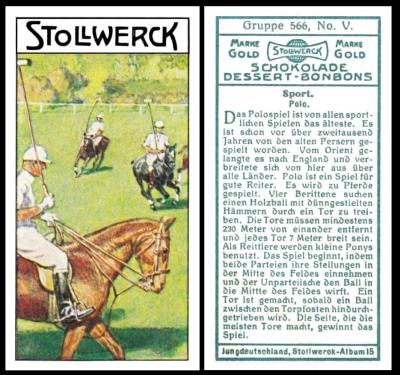
Stollwerck has been a German chocolate manufacturer since 1839, when it was founded by Franz Stollwerck in Cologne.
Franz Stollwerck was actually a baker. I do not know why he started to make chocolate, but he started out making hard candy, with a medicinal bias, and did particularly well with cough drops and lozenges. This was not greeted with kindness by local pharmacists, who protested, and even took it before the local council so that he would be made to stop, but he was not.
Then, in the 1860s, he started to not only bake cakes, but sell chocolate and marzipan. As chocolate and marzipan are often associated with cakes, perhaps the truth is that at one time he had too much filling and covering, and so he sold it, and people liked it, and so he made extra again. He also, by this time, ran a couple of coffee houses, perhaps why he started to make the cake. In any event he soon started to specialise in the sweets and the chocolate, and also opened bigger manufacturing premises. One of these was briefly converted into a music hall before becoming a chocolate and candy factory in the 1860s.
Franz Stollwerck died in 1876, and his five sons took over the business. Under their leadership the company expanded rapidly, into other countries as well. And they turned to technology, producing the first ever chocolate vending machines in 1887, from which you could extract a small sample of their product.
This then expanded to a network of machines from which larger bars of chocolate were sold; not just chocolates, too, they also had machines, especially at railway stations, for cigarettes, and soap (though hopefully not together), and, most intriguingly, for the sale of railway tickets.
Now the text on this card is primarily a history of polo, and it tells us that it is the oldest sport of all, two thousand years old, being first played in Persia. From the Orient it travelled to England and thence to other lands. It adds that polo is a sport for good riders. and good horses, though it also stresses that they are not strictly horses, but little ponies. It also gives us the dimensions of the field, 230 metres from end to end and seven metres as the span of the goal posts. This is not so far off today, when the playing area is 274 metres long and the goal posts 7.3 metres apart - the difference in the field dimensions being caused by the fact that there are now additional safety areas to protect the spectators, nine metres at each side and almost twenty-eight metres at top and bottom behind the goals.
The fronts of the cards that make up this group of six can be seen in full colour at Pre-War Cards/Stollwerck566. Looking at them it is plain to see that there are three sub-sets, golf, tennis, and horse sports, and that each pair consists of men and of women.
The female rider seems to be an odd woman out though, as it is not apparently clear which branch of equestrianism she represents. She is on a background with no other riders, but which could easily have shown a huntsman at full cry, or some hounds, and if she were doing dressage she would be dressed in a black habit, not a grey one. It appears that she is simply hacking, or enjoying riding in open country, but that would again be an anachronism because all the other cards show competitive sport.
Wednesday, 7th August 2024
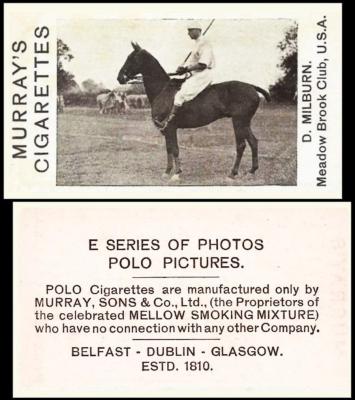
It is hard to find much information about this set, all I know is that it is part of a group of sets that are all inscribed with series letters.
It is described in our original World Tobacco Issues Index as :
E SERIES OF PHOTOS - POLO PICTURES. Sm. 68 x 39-40. Sepia. Unnd. (25) See H.296 ... M164-9
And this text, though not the code, remains the same in our updated version. Now the Handbook code, H296, is actually incorrect, it ought to read H.294. The listing there is rather too long to type because it lists all the card titles - so I have scanned it.
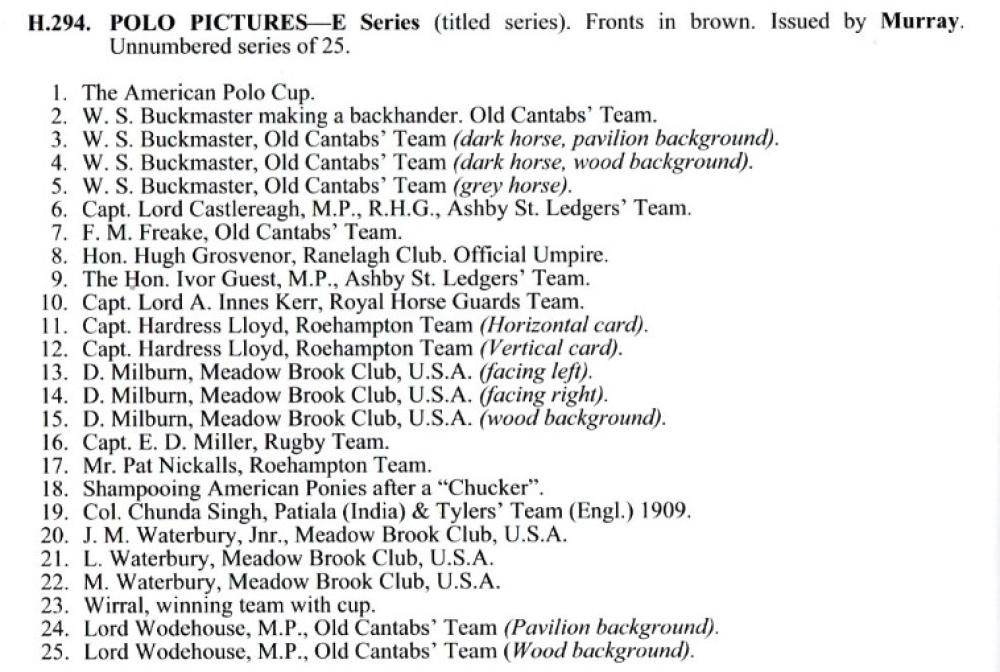
What I have found out is quite a bit about some of the players.
Walter Selby Buckmaster, the subject of cards 2-5, was born on the 16th of October 1872, and he was British. He was also on two Olympic Polo teams, the first one in 1900, where he was on the BLO team, and won a silver medal, and the second one in 1908 with the Hurlingham club, and he won a second silver medal. The reference here to "Old Cantabs" refers to the fact that he was at Cambridge University. During the First World War he served in the French Red Cross as an ambulance driver, which might even have been a horse drawn ambulance.
Frederick Maitland Freake, card 7, was also in the Old Cantabs team. He was also at both the above Olympics, on the same squads. He seems to have moved about a bit in the First World War, but ended up in the Royal Field Artillery. Again, this was a horse oriented regiment.
John Hardress Lloyd, cards 11 and 12, was Anglo-Irish, and was born on the 14th of August 1874. He was on the Irish team (though this was counted as part of Great Britain) at the 1908 Olympics, winning a silver medal. He also served in the First World War, both in Europe and Gallipoli, winning the Distinguished Service Order - as well as being of an age to also take part in many other earlier wars including the Second Boer War, where he was with the 21st Lancers, another horse regiment. Strangely, though, by 1917 he was in the Tank Brigade, reaching the rank of Brigadier General.
As for our man, showing here, on cards 13, 14 and 15, that was Devereux Milburn, and he was born on September 19th, 1881, in Buffalo, New York. He was once considered to be the best polo player in the whole of America, and he won the celebrated Westchester Cup an amazing six times. His father was a lawyer, which kind of explains how our man had the money to play polo and afford the best ponies, and to go to Oxford University, where he was also a champion swimmer. During the First World War, he was a Major in the Field Artillery, and afterwards he and his brother became lawyers with the family firm. He also got married and had four children. However he died, aged just sixty, from a heart attack, whilst playing golf. Strangely this was at the Meadow Brook Polo Club, on Long Island
Thursday, 8th August 2024
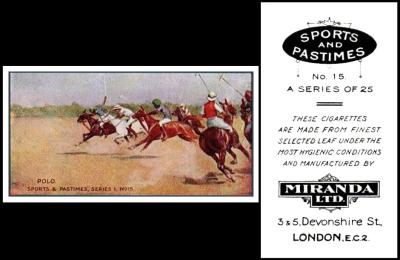
This is an unusual card for its time, because if you look closely you will see that it appears to be a match between Indians, see the man in a turban, and Europeans, though most probably British. Most of the other sets and cards of polo seem to gloss over any mention of India, and yet it was not us who introduced it to them, but the other way around. In fact the word "pulu" is also Indian, and it refers to the wooden ball that is struck during play.
Though it is often recorded that the game was first played in India in the early 1600s, modern investigations, and discoveries of early texts, can now date right back to a time of the gods, one of whom was known as the winged pony god, from a place called Manipur. Now Manipur has long been regarded as the birthplace of Indian polo, and the oldest polo ground in the world, the Imphal, is not surprisingly located in Manipur State, it reputedly was first used for the game in AD 33. Another curious fact about the area is that there is a particular breed of pony, there which is quite small, at only thirteen hands high. It seems therefore that the locals learned to play the game on the small native ponies and so, to this day, that is probably why small ponies have become the mount of choice - though today they are bred specifically and are more like miniature thoroughbreds than hardy native ponies.
Sadly we do not know much about this issuer, though the cards tell us that they were at numbers 3 and 5, Devonshire Street, London E.C.2. - and there is a bit more information in our "Directory of British Issues", reference book RB.7, published in 1946, which reads :
MIRANDA LTD.
130 New North Road, London N.1.
(See also entry under Challis)
Previously : 3-5 Devonshire Street, Bishopsgate, London E.C.2.
"De Sefi", "Planters", "Miranda`s Dream".
Now taking this in order, the first three lines can be explained by the fact that R. S. Challis & Co. Ltd., of 130 New North Road, in London, bought Miranda Ltd and then they both shared the same address. Challis enjoyed buying up other companies, including the East London firm of Burstein, Isaacs & Co (which they bought in 1935), and H. W. Drapkin - though there is uncertainty as to whether the firms of R. & E. Boyd Ltd and Strathmore Tobacco were companies that they bought or just names that they created.
The line at the bottom are brands. I have been unable to find "De Sefi", but "Planters" was definitely continued by Challis after they assumed control. There was also "Everyman`s", "Lucky Dream", "Piccadilly G.T.", "Scented Lily", "Velvet", and Zaria". However it is possible that none of these issued cards. As for "Miranda`s Dream", this was one of their best sellers, along with "Ashes of Ambar", both of which were tipped cigarettes, either silk tipped, cork tipped, plain tipped, or what was described as "rose petals". "Miranda`s Dream" had one of the most enticing tins of all time, a lady sporting a long string of pearls reclines languidly in a chair, with a cigarette at a jaunty angle in a long black holder, whilst above, to her left, a dancing girl entertains a seated Indian Prince.
Despite all these brands, they only issued two sets - a set of 20 "Dogs" and this set of "Sports and Pastimes", which is described in our original World Tobacco Issues Index as :
SPORTS AND PASTIMES.Sm. 67 x 36. Nd. (25). See H.225 ...M116-2
Now that H.225 sends us to the handbook, but in this case there is a main listing for this set, and all its permutations, with the Taddy version, which is probably the most famous of them all, and which was Card of the Day on the fourth of February 2022. Or rather there will be a main listing in a minute, I am just working on that at the same time as this...
Friday, 9th August 2024
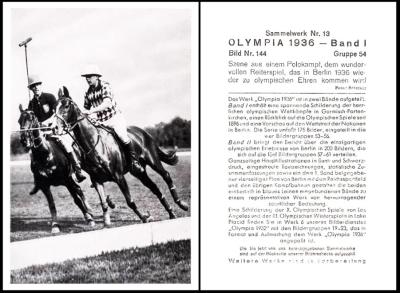
Here we have the perfect end to this week because it shows the 1936 Olympics in Berlin, and that was the last time polo was an Olympic sport.
Now the 1936 Summer Olympics were the eleventh. The selection for the host city had taken place back in May 1930, in Berlin, and fourteen cities had stepped forward. However by mid-1931, only Barcelona and Berlin were left to fight it out. Some of the ones who had withdrawn, for whatever reason, would host future Olympics - Helsinki, Rio de Janeiro, and Rome, which had been one of the favourites until it bowed out the day before the host was announced. Berlin pipped Barcelona to the post in the bid to host them, which seems a bit surprising given the political climate in the years leading up to the Second World War. Maybe Spain would not have been a great choice either though, because the first skirmishings of the Spanish Civil War broke out in mid-July 1936, just a few weeks before the Olympic opening ceremony (on August 1st). Even Rome, by that time, was fighting Ethiopia in an attempt to take the country over.
The last Olympics had been in Los Angeles, America. They had been a success, but times were hard, the Great Depression was in full swing, and many competitors simply could not attend, likewise there was a shortage of spectators. Only thirty-seven countries sent teams, nine less than attended the Amsterdam Olympics in 1932. Interestingly, the selection of Los Angeles had been made in 1923, when the world was still attempting to get up after the First World War, and Los Angeles was the only prospective host to bid for them. This may have been because America entered the war late, and also did not suffer the property and other war related damages that the Europeans had done.
The Berlin Olympics spared no expense, building new arenas and stadiums, and road infrastructure. It is not untrue to say that it was to be a showcase, to prove that the Germans may have had to suffer vast reparations but they were still a force to be reckoned with. In war, too, and the clouds were definitely already gathering. It is definitely also the fact that there was also a great desire to have as much of it as possible filmed for posterity, so that the World could see what Germany could do. They were also, sadly, used for propaganda, and were tarnished by racial intolerance. Even these cards, and the album cover, contain images that are likely to cause sadness, and offence - almost a hundred years later. This card is okay. And there are lots of wonderful sporting endeavours within the set as well; triumphs against all the odds, however unpopular they were with the regime at the time.
I wish I could tell you who the players on this card were, but it seems that will take a few more hours yet. Maybe longer. It also does not appear that they wore team colours, just to make things harder.
Now this card, to all intents and purposes, is anonymous, all you will find on it is "Zigaretten Bilderdienst" which means cigarette pictures.
The important bit to look for are the first words on the cards, "Sammelwerk Nr." (or Collection No.) - for that was used by Reemstma, and they used it as the first line on every card in their sixteen sets.
In our original World Tobacco Issues Index this set turns out to have a companion, and they are both listed as :
SAMMELWERK NR. 13 : OLYMPIA 1936 - BAND I. Size 120 x 80 (150) and 170 x 120 (25). Nd. (175). Anonymous ... R16-19
A. Partly black and white. Back refers to Band I only.
B. All black and white. Back refers to Band I and II.SAMMELWERK NR. 14 : OLYMPIA 1936 - BAND II. Size 120 x 80 (150) and 170 x 120 (25). Nd. (200). Anonymous ... R16-20
A. Partly black and white. Back not studied
B. All black and white. Back refers to Band I and II.
And, now, as they say in all the best cartoons, that`s all folks. At least for this week.
Thanks to all the people who helped with the above, in any way, and those of who also kept me going in other ways when I faltered and stumbled. And thanks to our readers, even if I know not who you are, for being there, driving me on, and making me keep on treading the path to getting this done, so as not to disappoint you.
I will return next week.
